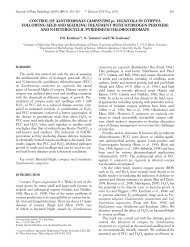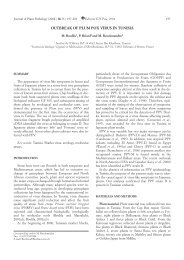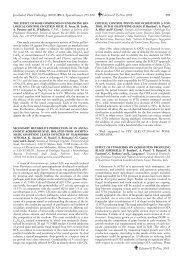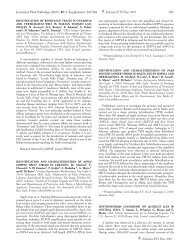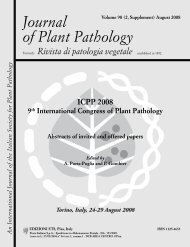Journal of Plant Pathology (2010), 92 (4, Supplement ... - Sipav.org
Journal of Plant Pathology (2010), 92 (4, Supplement ... - Sipav.org
Journal of Plant Pathology (2010), 92 (4, Supplement ... - Sipav.org
Create successful ePaper yourself
Turn your PDF publications into a flip-book with our unique Google optimized e-Paper software.
<strong>Journal</strong> <strong>of</strong> <strong>Plant</strong> <strong>Pathology</strong> (<strong>2010</strong>), <strong>92</strong> (4, <strong>Supplement</strong>), S4.71-S4.105 S4.75<br />
(family Lamiaceae), a native Mediterranean plant widespread in<br />
the Greek Ionian islands and Epirus, on which it causes mottling<br />
and deformation <strong>of</strong> the leaves. More recently, similar symptoms<br />
were observed in five species <strong>of</strong> Phlomis, namely P. chrysophylla<br />
Boiss., P. italica L., P. purpurea L., P. viscosa Poir., and P. fruticosa<br />
growing in the Botanical Garden <strong>of</strong> the University <strong>of</strong> Bari. Leaf<br />
samples were collected, processed for observation in the electron<br />
microscope, and subjected to RT-PCR analysis using a set <strong>of</strong> the<br />
already described primers FloNAB-FloNABr. Immunoelectron<br />
microscopy (IEM) assays were also done using a polyclonal antiserum<br />
raised in rabbits immunized with purified PhMV particles.<br />
Electron microscope observation <strong>of</strong> leaf dips from all Phlomis<br />
species revealed the consistent presence <strong>of</strong> filamentous flexuous<br />
particles ca. 850 nm long, resembling virions <strong>of</strong> PhMV, which<br />
were decorated by the antiserum to PhMV. RT-PCR assays amplified<br />
a single product <strong>of</strong> the expected size <strong>of</strong> 465 bp from all tested<br />
species. The results <strong>of</strong> this investigation widen the natural host<br />
range and geographical distribution <strong>of</strong> PhMV.<br />
PRELIMINARY RESULTS ON DISTRIBUTION AND DI-<br />
VERSITY OF GRAPEVINE YELLOWS IN TUSCANY. H.<br />
Bouyahia 1 , D. Rizzo 2 , S. Paltrinieri 3 , M. Della Bartola 1 , P. Braccini<br />
2 , C. Milano 4 , A. Materazzi 1 , A. Bertaccini 3 . 1 Dipartimento di<br />
Coltivazione e Difesa delle Specie Legnose “G. Scaramuzzi”,<br />
Sezione di Patologia Vegetale, Università degli Studi, Via del<br />
B<strong>org</strong>hetto 80, 56124, Pisa, Italy. 2 Agenzia Regionale per lo Sviluppo<br />
e l’Innovazione nel Settore Agricolo-Forestale (ARSIA), Laboratorio<br />
di Diagnostica Fitopatologica, Via dei Fiori 8, 51012 Pescia<br />
(PT), Italy. 3 Dipartimento di Scienze e Tecnologie Agroambientali,<br />
Sezione di Patologia Vegetale, Università degli Studi, Viale Fanin<br />
42, 40127 Bologna, Italy. 4 Dipartimento Provinciale ARPAT, Unità<br />
Operativa Agroecosistemi e Alimenti, Via Ponte alle Mosse 211,<br />
50144 Firenze, Italy. E-mail: hbouyahia@agr.unipi.it<br />
Grapevine yellows (GY) are an important threat to grapevine<br />
industry in Europe. In Italy, GY are mostly represented by<br />
Flavescence dorée (FD) and Bois noir (BN) associated with infection<br />
by 16SrV and 16SrXII phytoplasma ribosomal groups, respectively.<br />
In the frame <strong>of</strong> a regional strategy aimed at monitoring<br />
GY presence, an extensive survey was carried out covering the<br />
ten provinces <strong>of</strong> Tuscany (central Italy), and collecting 585 leaf<br />
samples in commercial vineyards inspected in summer 2009.<br />
Preference was given to samples showing symptoms referable to<br />
GY diseases. To allow tracking <strong>of</strong> FD-positive samples for uprooting,<br />
all vines were marked and localised by “Global Positioning<br />
System-GPS”. Nested-PCR and Real-time PCR confirmed<br />
that BN is largely the most important GY in Tuscany with an<br />
ubiquitous distribution. In fact, it was present in almost all surveyed<br />
vineyard with an overall incidence <strong>of</strong> 70% (418 out <strong>of</strong> 585<br />
samples tested). Alarming presence <strong>of</strong> FD was recorded in 23<br />
samples distributed in five provinces, i.e. Arezzo, Massa-Carrara,<br />
Florence, Siena and Lucca. Molecular characterization performed<br />
with PCR/RFLP analysis on 16S ribosomal and on SecY<br />
genes confirmed the presence <strong>of</strong> either FD-C and FD-D subgroups.<br />
FD-D is reported for the first time in Tuscany and is<br />
identical to the strain described earlier in France and in Veneto<br />
(northern Italy). Further investigations on insect vectors, natural<br />
reservoirs and molecular characterization <strong>of</strong> grapevine-infecting<br />
phytoplasmas are needed to monitor and understand the epidemiology<br />
GY diseases in Tuscany.<br />
EXTENSIVE SURVEY OF VIRUSES INFECTING AN<br />
OLIVE VARIETAL COLLECTION IN TUSCANY. H.<br />
Bouyahia 1 , D. Rizzo 2 , M. Della Bartola 1 and A. Materazzi 1 1 Dipartimento<br />
di Coltivazione e Difesa delle Specie Legnose “G. Scaramuzzi”,<br />
Sezione di Patologia vegetale, Università degli Studi, Via<br />
del B<strong>org</strong>hetto 80, 56124 Pisa, Italy. 2 Agenzia Regionale per lo<br />
Sviluppo e l’Innovazione nel Settore Agricolo-Forestale (ARSIA),<br />
Laboratorio di Diagnostica Fitopatologica, Via dei Fiori 8, 51012<br />
Pescia (PT), Italy. E-mail: hbouyahia@agr.unipi.it<br />
The occurrence was investigsted <strong>of</strong> olive-infecting viruses in<br />
the regional varietal collection at the experimental station “Santa<br />
Paolina” (CNR-IVALSA, Follonica-Grosseto). Starting from<br />
2004, a total <strong>of</strong> 245 mother plants belonging to 26 different Tuscan<br />
olive varieties were sampled an tested for the presence <strong>of</strong><br />
nine olive viruses. Largely grown varieties like Leccino, Frantoio<br />
and Moraiolo and the less known Correggiolo, Grappolo, Leccio<br />
del Corno, etc. were included. Hardwood cuttings taken from<br />
different part <strong>of</strong> the canopy were sampled twice a year (spring<br />
and autumn). Cortical scrapings were powdered in liquid nitrogen<br />
and total RNA was extracted. During the first years, cDNA<br />
synthesis followed by PCR was employed and successively replaced<br />
by one-Step RT-PCR for the detection <strong>of</strong> Arabis mosaic<br />
virus (ArMV), Cherry leafroll virus (CLRV) Cucumber mosaic<br />
virus (CMV), Olive latent virus 1 (OLV-1), Olive latent virus 2<br />
(OLV-2), Olive ringspot virus (OLRSV), Olive leaf yellowing-associated<br />
virus (OLYaV), Strawberry latent ringspot virus (SLRSV)<br />
and Tobacco necrosis virus (TNV). Seventeen <strong>of</strong> 245 samples<br />
(6.9%) were infected. Of the nine virus tested for only ArMV,<br />
CLRV, OLYaV and SLRSV were detected and no cases <strong>of</strong> mixed<br />
infections were found. Specifically, six mother plants <strong>of</strong> cvs Leccino,<br />
Frantoio and San Fancesco were infected with OLYaV. Ar-<br />
MV was found in cvs Correggiolo, Olivastra and Ornellaia and<br />
four mother plants <strong>of</strong> cvs Moraiolo and Maurino were positive to<br />
CLRV. Two positive samples to SLRV were detected in cvs Maurino<br />
and Grappolo. As previously reported, we confirmed a satisfactory<br />
sanitary status <strong>of</strong> olive germplasm in Tuscany.<br />
Work partially funded by “Progetto Interregionale-Qualificazione<br />
del vivaismo olivicolo – OLVIVA”.<br />
INCIDENCE AND DISTRIBUTION OF BOIS NOIR IN<br />
YOUNG VINEYARDS IN TUSCANY. P. Braccini 1 , D. Rizzo 1 ,<br />
T. Cinelli 2 , G. Marchi 2 . 1 Agenzia Regionale per lo Sviluppo e l’Innovazione<br />
nel Settore Agricolo-Forestale (ARSIA), Via Pietrapiana<br />
30, 50121 Firenze, Italy. 2 Dipartimento di Biotecnologie Agrarie,<br />
Sezione di Protezione delle Piante, Università degli Studi, Piazzale<br />
delle Cascine 28, 50144 Firenze, Italy. E-mail: guido.marchi@<br />
unifi.it<br />
The spread <strong>of</strong> bois noir was monitored from 2005 to 2009 in<br />
seven vineyards <strong>of</strong> cv. Sangiovese established in 2001 in Tuscany<br />
(central Italy). In each season the number and position <strong>of</strong> the<br />
vines showing typical symptoms (leaf discolouration, downward<br />
rolling <strong>of</strong> leaves, incomplete lignification <strong>of</strong> canes, shrivelled<br />
bunches) were recorded. Only the presence <strong>of</strong> 16SrXII-A phytoplasmas<br />
was ascertained by PCR analysis on bulk samples <strong>of</strong><br />
symptomatic leaves. With the purpose <strong>of</strong> determining the spatial<br />
pattern <strong>of</strong> the disease (random vs. aggregated or clustered), for<br />
each year <strong>of</strong> assessment, field data on annual incidence were analyzed<br />
at three spatial levels (hierarchies) including: (i) adjacent<br />
vines within the row and across the rows (ordinary runs analysis),<br />
(ii) within vines grouped into sampling units (distribution analysis)<br />
and (iii) among groups <strong>of</strong> plants at some distance from one<br />
another (SADIE-Spatial Analysis by Distance Indices). As a<br />
whole, the pattern <strong>of</strong> temporal disease incidence showed a similar<br />
trend in six <strong>of</strong> the seven study sites: annual incidence rate progressively<br />
decreased from year to year after the first or second



